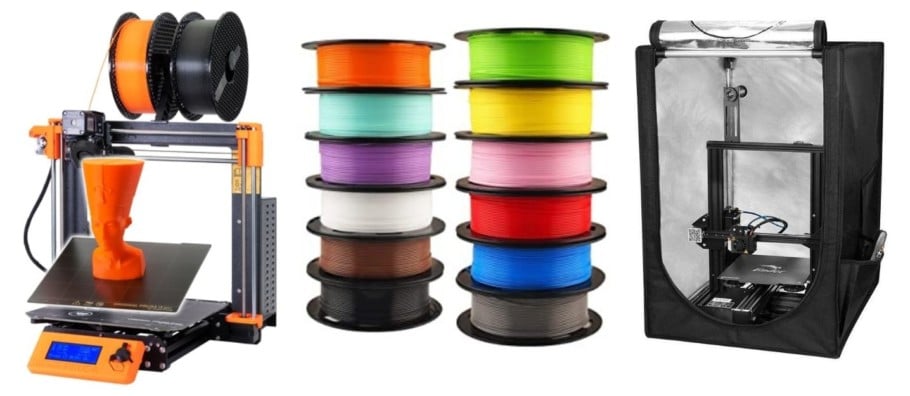Did you know that there are some filaments that can actually carry electricity? While they may not be widely known, or used for that matter, there definitely are conductive filaments out there that you can get to print some insanely interesting projects.
Now the question is, how conductive is regular PLA and are there any PLA Variants that are conductive?
I will answer both those questions in this article, as well as cover what issues you may run into when printing with conductive filaments, what filaments to get, and more.
So, let’s get started!
Is PLA filament conductive?
PLA falls in the category of non-conduct filaments because it has a resistivity in the order of 1016 Ωm, similar to most other plastic types, making it a great electrical insulation material as long as it is in a solid state (cold). Once heated, PLA will soften and become more conductive and no longer safe to use as an insulation material.
Polylactic acid (PLA) is a biodegradable thermoplastic, and like I just mentioned, it can be an excellent electrical insulator in the range from room temperature to about 70 °C. You can use PLA for electrical insulation needs because its resistivity and breakdown strength – up to 70 °C – is similar to Low-density polyethylene (LDPE) and other petroleum-derived plastic polymers, making it extremely non-conductive when it’s in its solid state.
Having said that, the problem with using PLA in electrical applications as an insulator is that its electrical conductivity is highly dependent on temperature; at temperatures above its glass transition temperature Tg (70 °C), PLA’s electrical conductivity significantly increases.
The reason for this is that PLA transitions into a rubbery state at temperatures above its Tg which leads to a sudden and significant rise in its electrical conductivity due to the micro-Brownian motion of its molecular chains.
Because PLA loses its insulating properties with the rise in temperature, it’s not advisable to use it in high-heat generating electrical applications, since it could lead to shorting. However, PLA is perfectly suitable to be used with low-voltage and low-heat applications.
Are there any conductive filaments?
A limited range of conductive filaments are available right now and are quickly becoming more popular among the DIY community. But don’t get too excited, at the moment, these filaments are only suitable to be used in simple circuits and small electronic projects, but you can still use them to make useful and exciting stuff ranging from 3D models decorated with embedded LEDs to auto-bed leveling sensors.
The most popular and, to my knowledge, useful conductive filament is Protopasta’s Conductive PLA. It has a resistivity of 15Ohms per centimeter, wi\hich makes it suitable for connecting simple electronic components, such as sensors, buttons, led lights, and others.
Conductive PLA filaments are generally formed by adding graphene, graphitized carbon and other additives, which increase the conductivity of normal PLA. They are only suitable for low-voltage circuits where voltage and current stays under 60 volts and 100 mA respectively, but these limits can vary amongst various filament types and brands.
There are multiple brands that are manufacturing these types of filaments which I’ll get to in a second, just know that these types of conductive filaments are far more expensive and won’t allow you to create complex circuitry or anything of that sort.
How conductive are these filaments?
Not all filament types and brands available out there are equally conductive, so make sure to pay attention to the electrical resistivity rating of the filament before you decide to purchase it.
The resistivity of an electrical conductor is just a measure of how well its material resists the flow of current. It is measured in Ωcm and is inversely related to conductivity; the lower the resistivity, the more conductive the material will be.
Luckily, all of this information is available right there on the filament roll or manufacturer’s site.
Conductive 3D prints have a fascinating behavior and generally aren’t equally conductive in every plane since they are printed along the X and Y axis continuously but along the Z axis the layers are extruded on top of each other, which means that there will be less contact surface, and therefore, less conductivity along the Z axis than along the X and Y axis.
Essentially, when it comes to a print’s orientation, you will want to be sure that it’s printed in the right orientation so that the parts that need to be the most conductive have more overall contact surface.
Examples of Conductive Filaments
Conductive PLA Proto-Pasta Filament: is a PLA-based filament with a resistivity of 15 ohm.cm and is available in diameters of 1.75mm and 2.85mm. It requires a printing temperature of 195-225ºC and bed temperature of 50-60ºC.
Electrifi Conductive Filament: is a proprietary metal-polymer composite that consists primarily of a biodegradable polyester (most likely PLA) and copper. It costs $196.00 per 100 grams and has a resistivity of 0.006 Ω.cm. It is available in diameters of 1.75mm and 2.85mm. It requires a printing temperature of 130-160 ºC and bed temperature of 50-60ºC.
SUNLU ABS Conductive Filament: is an ABS-based filament that costs $40.01 per 1 KG. It is available in only 1.75mm diameter. It requires a printing temperature of 220-240 ºC and bed temperature of 20-120ºC.
AMOLEN Conductive Black PLA Filament: is PLA based filament that costs $22.99 per 200 grams. It has a resistivity of 1.42 Ω .cm and is available in only 1.75mm diameter. It requires a printing temperature of 220-250ºC and bed temperature of 0-50ºC.
Uses of Conductive Filaments
Conductive filaments have enabled us to develop lightweight, durable and flexible low-voltage electrical circuits which is considered a breakthrough in the field of wearable electronics as 3D printed flexible electrical sensors can be seamlessly integrated into clothes, for example.
Conductive filaments can also be useful in the telecommunications field for printing highly customized electromagnetic and radio frequency shields, filters, antennas and other components. Industrial and scientific laboratories and health care institutions can benefit from using 3D printed EMI and RF shields against competing signals which may render sensitive equipment faulty.
Engineers, Makers and DIY enthusiasts can use conductive filaments to make different types of circuits, capacitive sensors of any shape for industrial and engineering applications, keyboards, game controllers, and exciting Arduino projects.
Just remember that conductive filaments can’t be used for high-voltage, or high-heat applications since they will melt and short.
Free prints to test Conductive Filaments
Some very creative people found ways of using conductive filaments to create some amazing 3D prints, some more functional than others clearly, but imagination is the limit here.
If you are interested in finding more ingenious 3d prints designed to be printed with conductive filament, then check out this article on Hackday or use our own search engine to find files to print.
Issues of printing with Conductive Filament
Shorting issues: Like I previously mentioned, PLA’s glass transition temperature is about 70°C, which means that once it reaches that temperature it will soften and become more conductive, which could lead to shorting. Essentially, don’t use conductive PLA unless you know that it will never get close to those temperatures.
Conductive Filaments are abrasive: Conductive PLA is generally infused with Carbon and this gives it its conductive properties, but it becomes extremely abrasive on the extruder nozzle. If you’re using a brass nozzle, you’re probably be replacing it after printing just 500g of filament.
Nozzle Clogging: Conductive filaments are harder to print, which means that printing speed should be lowered while the nozzle temperature should be increased as well in order to avoid clogging.
Conclusion
Conductive filaments are one of the most fun additions to the 3D printing world, even though they can’t really replace actual copper wiring. But if you want to make a gaming controller, a flashlight, or even that terminator head with led light I linked earlier, then conductive filament is the way to go.
Just remember to use it wisely and to avoid electrical shorting!
I hope this information was useful!
Have a great day!
Check out our recommended products section

We created a recommended products section that will allow you to remove the guesswork and reduce the time spent researching what printer, filament, or upgrades to get, since we know that this can be a very daunting task and which generally leads to a lot of confusion.
We have selected just a handful of 3D printers that we consider to be good for beginners as well as intermediates, and even experts, making the decision easier, and the filaments, as well as the upgrades listed, were all tested by us and carefully selected, so you know that whichever one you choose will work as intended.
Error processing API data.
